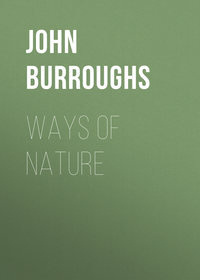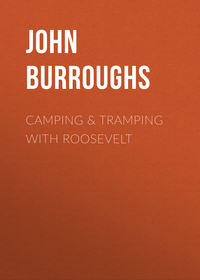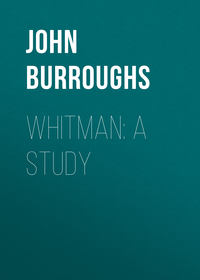 полная версия
полная версияUnder the Maples
The writers who go directly to life and Nature for their material are, in every age, few compared with the great number that go to the libraries and lecture-halls, and sustain only a second-hand relation to the primary sources of inspiration. They cannot go directly to the fountain-head, but depend upon those who can and do. They are like those forms of vegetation, the mushrooms, that have no chlorophyll, and hence cannot get their food from the primary sources, the carbonic acid in the air; they must draw it from the remains of plants that did get it at first-hand from Nature. Chlorophyll is the miracle-worker of the vegetable world; it makes the solar power available for life. It is in direct and original relation to the sun. It also makes animal life possible. The plant can go to inorganic nature and through its chlorophyll can draw the sustenance from it. We must go to the plant, or to the animal that went to the plant, for our sustenance.
The secondary men go to books and creeds and institutions for their religion, but the original men, having the divine chlorophyll, go to Nature herself. The stars in their courses teach them. The earth inspires them.
V. THE COSMIC HARMONYThe order and the harmony of the Cosmos is not like that which man produces or aims to produce in his work – the order and harmony that will give him the best and the quickest results; but it is an astronomic order and harmony which flows inevitably from the circular movements and circular forms to which the Cosmos tends. Revolution and evolution are the two feet upon which creation goes. All natural forms strive for the spherical. The waves on the beach curve and roll and make the pebbles round. From the drops of rain and dew to the mighty celestial orbs one law prevails. Nature works to no special ends; she works to all ends; and her harmony results from her universality. The comets are apparently celestial outlaws, but they all have their periodic movements, and make their rounds on time. Collisions in the abysses of space, which undoubtedly take place, look like disharmonies and failures of order, as they undoubtedly are. What else can we call them? When a new star suddenly appears in the heavens, or an old one blazes up, and from a star of the tenth magnitude becomes one of the first, and then slowly grows dim again, there has been a celestial catastrophe, an astronomic accident on a cosmic scale. Had such things occurred frequently enough, would not the whole solar system have been finally wrecked, or could it even have begun? For the disharmonies in Nature we must look to the world of the living things, but even here the defeats and failures are the exception – else there would be no living world. Organic evolution reaches its goal despite the delays and suffering and its devious course. The inland stream finds its way to the sea at last, though its course double and redouble upon itself scores of times, and it travels ten miles to advance one. A drought that destroys animal and vegetable life, or a flood that sweeps it away, or a thunderbolt that shatters a living tree, are all disharmonies of Nature. In fact, one may say that disease, pestilence, famine, tornadoes, wars, and all forms of what we call evil are disharmonies, because their tendency is to defeat the orderly development of life.
The disharmonies in Nature in both the living and the non-living worlds tend to correct themselves. When Nature cannot make both ends meet, she diminishes her girth. If there is not food enough for her creatures, she lessens the number of mouths to be fed. A surplus of food, on the other hand, tends to multiply the mouths.
Man often introduces an element of disorder into Nature. His work in deforesting the land brings on floods and the opposite conditions of drought. He destroys the natural checks and compensations.
VI. COSMIC RHYTHMSThe swells that beat upon the shores of the ocean are not merely the result of a local agitation of the waters. The pulse of the earth is in them. The pulse of the sun and the moon is in them. They are more cosmic than terrestrial. The earth wears her seas like a loose garment which the sun and moon constantly pluck at and shift from side to side. Only the ocean feels the tidal impulse, the heavenly influences. The great inland bodies of water are unresponsive to them – they are too small for the meshes of the solar and lunar net. Is it not equally true that only great souls are moved by the great fundamental questions of life? What a puzzle the tides must have been to early man! What proof they afford of the cosmic forces that play upon us at all times and hold us in their net! Without the proof they afford, we should not know how we are tied to the solar system. The lazy, reluctant waters – how they follow the sun and moon, "with fluid step," as Whitman says, "round the world"! The land feels the pull also and would follow if it could. But the mobile clouds go their way, and the aerial ocean makes no sign. The pull of the sun and the moon is upon you and me also, but we are all unconscious of it. We are bodies too slight to affect the beam of the huge scale.
VII. THE BEGINNINGS OF LIFEIt is remarkable, I think, that Professor Osborn, in his "Origin and Evolution of Life," makes no account of the micro-organisms or unicellular lives that are older than the continents, older than the Cambrian rocks, and that have survived unchanged even to our times. I saw in the Grand Cañon of the Colorado where they were laid down horizontally on the old Azoic or original rocks, as if by the hand of a mason building the foundation of a superstructure. All the vast series of limestone rocks are made up from the skeletons of minute living bodies. Other strata of rocks are made up of the skeletons of diatoms. Some of our polishing powders are made from these rocks. Formed of pure silex, these rocks are made up of the skeletons of organisms of many exquisite forms, Foraminiferæ. The Pyramids are said to be built of rocks formed by these organisms. "No single group of the animal kingdom," says Mr. W. B. Carpenter, "has contributed, or is at present contributing, so largely as has the Foraminiferæ to the formation of the earth's crust." In the face of these facts, how unsatisfactory seem Professor Osborn's statements that life probably originated on the continents, either in the moist crevices of rocks or soils, in the fresh waters of continental pools, or in the slightly saline waters of the "bordering primordial seas." This last suggestion comes nearer the mark. There is no variation during geologic time of these primordial living organisms. All conceivable changes of environment have passed over them, but they change not. Bacteria struggle together, one form devouring another form. Unicellular life long precedes multicellular. Biologists usually begin with the latter; the former are fixed; with the latter begins development or evolution, and the peopling of the world with myriads of animal forms.
VIII. SPENDTHRIFT NATUREEmerson says, "Nature is a spendthrift, but takes the shortest way to her ends." She is like ourselves, she is ourselves written large – written in animal, in tree, in fruit, in flower. She is lavish of that of which she has the most. She is lavish of her leaves, but less so of her flowers, still less of her fruit, and less yet of her germinal parts. The production of seed is a costly process to the plant. Many trees yield fruit only every other year.
I say that Nature is a spendthrift only of what she has the most. Behold the clouds of pollen from the blooming pines and from the grasses in the meadow. She is less parsimonious with her winged seeds, such as of the maple and the elm, than with her heavy nuts – butternuts, hickory-nuts, acorns, beechnuts, and so on. All these depend upon the agency of the birds and squirrels to scatter them. She offers them the wage of the sweet kernel, and knows that they will scatter more than they eat. To all creatures that will sow the seeds of her berries she offers the delectable pulp: "Do this chore for me, and you will find the service its own reward." All the wild fruits of the fields and woods hold seeds that must be distributed by animal agency. Even the fiery arum or Indian turnip, tempts some birds to feast upon its red berries, and thus scatter the undigested seeds. The mice and the squirrels doubtless give them a wide berth, but in the crop of the fowl the seeds have the sting taken out of them. You cannot poison a hen with strychnine.
We ourselves are covetous of those things of which we have but few, extravagant with those of which we have an abundance. When the Western farmer burns corn in place of coal, be assured he sees his own account in it. We husband our white pine, and are free with our hemlock; we are stingy with our hickory, and open-handed with our beech and chestnut.
XII
NEW GLEANINGS IN FIELD AND WOOD
As I saunter through the fields and woods I discover new acts in Nature's drama. They are, however, the old acts, played again and again, which have hitherto escaped my notice, so absorbed have I been in the rise and fall of the curtain, and in the entrances and exits of the more familiar players. I count myself fortunate if, during each season, I detect a few new acts on the vast stage; and as long as I live I expect to cogitate and speculate on the old acts, and keep up my interest in the whole performance.
I. SUNRISEThe most impressive moment of the day here in the Catskills is the rising of the sun. From my cot on the porch I see the first flash of his coming. Before that I see his rays glint here and there through the forest trees which give a mane to the mountain crest. The dawn comes very gently. I am usually watching for it. As I gaze I gradually become conscious of a faint luminousness in the eastern sky. This slowly increases and changes to a deep saffron, and then in eight or ten minutes that fades into a light bluish tinge – the gold turns to silver. After some minutes the sky, just at the point where the sun is to appear, begins to glow again, as if the silver were getting warm; a minute or two more and the brow of the great god is above the horizon line. His mere brow, as I try to fix my eye upon it, fairly smites me blind. The brow is magnified by the eye into the whole face. One realizes in these few seconds how rapidly the old earth turns on its axis. You witness the miracle of the transition of the dawn into day. The day is born in a twinkling. Is it Browning who uses the word "boil" to describe this moment? – "Day boils at last." Gilder, I think, speaks of it as a scimitar flashing on the brim of the world. At any rate, I watch for it each morning as if I were seeing it for the first time. It is the critical moment of the day. You actually see the earth turning. Later in the day one does not note in the same way the sun climbing the heavens. The setting sun does not impress one, because it is usually enveloped in vapors. His day's work is done and he goes to his rest veiled and subdued. He is new in the morning and old at his going down. His gilding of the clouds at sunset is a token of a fair day on the morrow; his touching them with fire in the morning is a token of wind or storm. So much we make of these things, yet the sun knows them not. They are local and only earth phenomena, yet the benefaction of the sun is as if it shone for us alone. It is as great as if this were the case, and yet the fraction of his light and heat that actually falls upon this mote of a world adrift in sidereal space is so infinitely small that it could hardly be computed by numbers. In our religion we appropriate God to ourselves in the same way, but he knows us not in this private and particular way, though we are all sharers in the Universal Beneficence.
II. NATURE'S METHODSNature baffles us by methods so unlike our own. Man improves upon his inventions, he makes them better and better and discards the old. The first airplane flew a few miles with its pilot; now the airplane flies hundreds of miles and carries tons of weight. Nature has progressed steadily from lower to higher forms, but she keeps all her lower forms; her first rude sketches are as precious to her as the perfected models. There is no vacancy at the bottom of her series, as there is in the case of man. I am aware that we falsify her methods in contrasting them with those of man in any respect. She has no method in our sense of the term. She is action, and not thought, growth and not construction, is internal and not external. To try to explain her in terms of our own methods is like trying to describe the sphere in terms of angles and right lines.
The origin of species is as dark a problem as is the origin of the secondary rocks. What factors or forces entered into the production of the vast variety of stratified rocks, differing as widely from the original Adam rock, the granite, as the races of men differ from one another? There is just as much room for natural selection to work in one case as in the other. We find where two kinds of rock touch, one overlying the other, and absolute difference in texture and color, and no union between them. How account for their juxtaposition? Rock begat rock, undoubtedly, and the aerial forces played the chief part, but the origin of each kind is hidden in the abyss of geologic time, as is that of the animal species.
The position of the camel with reference to the giraffe in Africa is analogous to that, say, of the Catskill conglomerate to the laminated sandstone that lies beneath it. They are kindred; one graduates into the other. Whence the long neck and high withers of the giraffe? The need of high feeding, say the selectionists, but other browsing animals must have felt the same need. Our moose is strictly a browsing animal, and, while his neck and shoulders are high, and his lips long, they do not approach those of the giraffe. The ostrich has a long neck also, but it is a low feeder, mainly from the ground.
We can only account for man and other higher forms of life surviving in the highway of the physical forces on the ground that the wheels and tramping hoofs missed them much oftener than they hit them. They learned instinctively to avoid these destructive forces. Animal life was developed amid these dangers. The physical forces go their way as indifferent to life as is your automobile to the worms and beetles in the road. Pain and suffering are nothing to the Eternal; the only thing that concerns It is the survival of the fit, no matter how many fall or are crushed by the way; to It men are as cheap as fleas; and they have slaughtered one another in Europe of late without help or hindrance from the Eternal, as do the tribes of hostile ants. The wars of the microbes and the wars of men are all of a piece in the total scheme of things. The survivors owe their power of survival to the forces that sought their destruction; they are strong by what they have overcome; they graduated in that school. Hence it is that we can say that evil is for us as much as it is against us. Pain and suffering are guardian angels; they teach us what to shun.
How puzzling and contradictory Nature often is! How impossible, for instance, to reduce her use of horns to a single rule. In the deer and elk tribe the antlers seem purely secondary sexual characteristics. They are dropped as the season wanes; but the antelopes do not drop their horns, and in Africa they are singularly ornamental. But with our common sheep the horns are sexual manifestations; yet the old ram does not shed his horns. Nature will not be consistent.
Back in geologic time we had a ruminant with four horns, two on the nose and two on the crown, and they were real, permanent, bony growths.
What a powerful right fore limb Nature has given to the shovel-footed mole, while the chipmunk, who also burrows in the ground, has no special tool to aid him in building his mound of earth; he is compelled to use his soft, tender little nose as a pusher. When the soil which his feet have loosened has accumulated at the entrance to his hole, he shoves it back with his nose.
Even to some of her thistles Nature is partial. The Canada thistle sows its seeds upon the wind like the common native thistle; then in addition it sends a big root underground parallel with its surface, and just beyond the reach of the plough, which sends up shoots every six or seven inches, so that, like some other noxious weeds, it carries on its conquests like a powerful besieging army, both below ground and above.
A bachelor of laws in Michigan writes me in a rather peremptory manner, demanding an answer by return mail as to why robins are evenly distributed over the country instead of collected in large numbers in one locality; and if they breed in the South; and he insists that my answer be explicit, and not the mere statement "that it is natural law." I wonder that he did not put a special-delivery stamp on his letter. He is probably wondering why I am so dilatory in answering.
There seems to be an inherent tendency in nearly all living things to scatter, to seek new fields. They are obeying the first command – to increase and multiply. Then it is also a question of food, which is limited in every locality. Robins do not breed in flocks, but in pairs. Every gas is a vacuum to every other gas; and every locality is a vacuum to the different species of birds that breed there. The seed-eaters, the fruit-eaters, the insect-eaters, and the omnivorous feeders, like the robin – in other words, the sparrows, the flycatchers, the warblers – may and do all live together in harmony in the same narrow area.
The struggle of which we have heard so much since Darwin's time is mainly a natural sifting and distributing process, such as that going on all about us by the winds and the waters. The seeds carried by the winds do not thrive unless they chance to fall on suitable ground. All may be "fit" to survive and yet fail unless they are also lucky. What so frail as a spider's web, and yet how the spiders thrive! Nature gives the weak many advantages.
There is a slow, bloodless struggle of one species with another – the fleet with the slow, the cunning with the stupid, the sharp-eyed and sharp-eared with the dull of eye and ear, the keen of scent with the blunt of scent – which we call natural competition; but the slow, the stupid, the dull-eyed, dull-eared, and dull-scented find their place and thrive for all that. They are dull and slow because they do not need to be otherwise; the conditions of their lives do not require speed and sharpness. The porcupine has its barbed quills, the skunk its pungent secretion. All parts of nature dovetail together. The deer and the antelope kind have speed and sharp senses because their enemies have speed and sharp senses. The small birds are keen-eyed and watchful because the hawks are so, too. The red squirrel dominates the gray squirrel, which is above him in size and strength, and the chipmunk below him, but he does not exterminate either. The chipmunk burrows in the ground where the red cannot follow him, and he lays up a store of nuts and seeds which the red does not. The weasel easily dominates the rat, but the rat prospers in spite of cats and traps and weasels.
The sifting of species is done largely by environment, the wet, the cold, the heat – the fittest, or those best adapted to their environment, survive. For some obscure reason they have a fuller measure of life than those who fall by the way.
III. HEADS AND TAILSI have heard a story of a young artist who, after painting a picture of a horse facing a storm, was not satisfied with it, and, feeling that something was wrong, asked Landseer to look at it. Instantly the great artist said to him, "Turn the horse around."
The cow turns her head to the storm, the horse turns his tail. Why this difference? Because each adopts the plan best suited to its needs and its anatomy. How much better suited is the broad, square head of the cow, with its heavy coating of hair and its ridge of bone that supports its horns, to face the storm than is the smooth, more nervous and sensitive head of the horse! What a contrast between their noses and their mode of grazing! The cow has no upper front teeth; she reaps the grass with the scythe of her tongue, while the horse bites it off and loves to bite the turf with it. The lip of the horse is mobile and sensitive. Then the bovine animals fight with their heads, and the equine with their heels. The horse is a hard and high kicker, the cow a feeble one in comparison. The horse will kick with both hind feet, the cow with only one. In fact, there is not much "kick" in her kind. The tail of the cow is of less protection to her than is that of the horse to him. Her great need of it is to fight flies, and, if attacked in the rear, it furnishes a good hold for her enemies. Then her bony stern, with its ridges and depressions and thin flanks, is less fit in any encounter with storm or with beast than is her head. On the other hand, the round, smooth, solid buttocks of the horse, with their huge masses of muscles, his smooth flanks, and his tail – an apron of long, straight, strong hair – are well designed to resist storm and cold. What animal is it in Job whose neck is clothed with thunder? With the horse, it is the hips that are so clothed. His tremendous drive is in his hips.
IV. AN UNSAVORY SUBJECTIf a rose by any other name would smell as sweet, I suppose the breath of the obscene fungus by any other name would smell as rank. The defensive weapon of our black-and-white wood pussy would probably not be less offensive if we called him by that name alone, instead of the common one by which he is universally known.
While in southern California last winter I heard of one that took up his abode in the basement of a house that stood on the side of a hill in the edge of the country. It was in a sort of lumber-room where all sorts of odds and ends had accumulated. On some shelves was a box of miscellaneous articles, such as lids to tin cans, bed castors, old toothbrushes, bits of broken crockery, pieces of wire, chips of wood, and the dried foot and leg of a hen. One morning, on opening the door of the basement, the mistress of the house was surprised to see the whole collection of trash laid out in a line across the floor. The articles were placed with some degree of regularity covering a space about fifteen inches wide and ten feet in length. There were sixty-one articles in the row.
Having such an unsavory creature in the basement of one's house is rather ticklish business; not so perilous as a stick of dynamite, yet fraught with unpleasant possibilities. They cleared away the exhibit and left the door open, hoping their uninvited guest would take his departure. But he did not. A few nights later he began another collection, finding a lot of new material – among other things a box with old atomizer bulbs, four of which bulbs he arranged here and there, in the row – a motley array.
What is his object? I confess I do not know. No one has seen him do it, as he works at night, but there is little doubt that it is his work.3 The Western skunk is a small creature, not much bigger than a gray squirrel. He can hide behind a dustpan.
I wish some one would tell me why this night prowler so often seems to spray the midnight air with his essence which leaves no trace by day. He never taints his own fur with it. In the wilds our Eastern species is as free from odor as a squirrel or a woodchuck. Kill or disturb one by day or night in his haunts, and he leaves an odor on the ground that lasts for months. While at a friend's house in the Catskills last August a wood pussy came up behind the kitchen and dug in the garbage-heap. We saw him from the window in the early evening, and we smelled him. For some reason he betrayed his presence. Late that night I was awakened by a wave of his pungent odor; it fairly made my nose smart, yet in the morning no odor could be detected anywhere about the place. Of course the smell is much more pronounced in the damp night air than by day, yet this does not seem an adequate explanation. Does he signal at night to his fellows by his odor? He has no voice, so far as I know. I have never heard him make a vocal sound. When caught in a trap, or besieged by dogs in a stone wall, he manifests his displeasure by stamping his feet. He is the one American who does not hurry through life. I have no proof that he ever moves faster than a walk, or that by any sign, he ever experiences the feeling of fear, so common to nearly all our smaller animals. His track upon the snow is that of a creature at peace with all the world.









